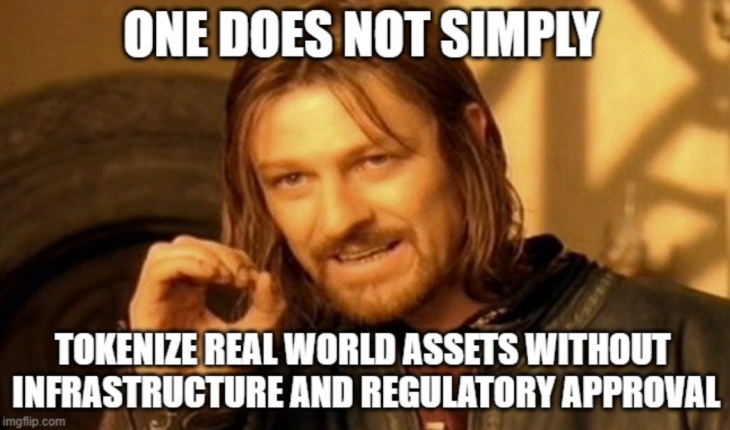
In the ever-evolving financial landscape, tokenization delivers new opportunities and considerations for investors around the globe. As we navigate through the ongoing downturn in crypto markets, exploring tokenized assets becomes a beacon of potential. It’s a journey through uncharted territories, where commodities, real estate, and financial assets are all intertwined in the digital realm, offering a diversified investing palette.
I’ve written before about the tokenization of real-world assets, so it only made sense for me to delve more deeply into the Federal Reserve paper on tokenization. I found a narrative that uncovers the intricacies of tokenized commodities, real estate, and financial assets, shedding light on their implications, challenges, and transformative potential for the investment world.
Today’s piece is my journey through this document, an exploration to unravel the implications of tokenization for investors, the opportunities it presents, and the speculative future hinted at by the authors.
The Golden Path of Tokenization
With roughly $2.15 billion in tokenized assets on permissionless blockchains as of May 2023, gold shines brightest, with nearly half being tokenized gold. This makes the golden path of tokenization a metaphor and a tangible reality, locking gold in the digital realm, thus creating a bridge between the tangible and the intangible.
The Fed paper highlights the significant presence of tokenized gold, a market with a capitalization hovering around $1 billion as of May 2023. It’s a domain dominated by Pax Gold (PAXG) and Tether Gold (XAUt), with the two controlling 99% of the market. These digital representations of gold are not merely reflections of reality but are fully redeemable, allowing holders to claim the underlying physical gold, albeit with certain restrictions and fees.
For digital investors, this opens up a realm of possibilities and considerations. The ability to own and trade tokenized gold offers a unique blend of liquidity and stability. However, it’s a journey that requires nerves of steel, careful consideration of the redeemability features, and an understanding of the inherent risks and benefits.
The trajectory of tokenized commodities is a testament to the evolving dynamics of the investment world. It’s a path paved with golden opportunities but also with speculative uncertainties. Will tokenization increasingly improve the investing landscapes, or will the complexities of the digital ecosystem hamper its growth?
Building Wealth, One Token at a Time
Gold isn’t the only tokenized asset class. Tokenized real estate is a growing sector, allowing us to build wealth, one token at a time.

The paper mentions Real Token Inc. (RealT) as a pioneer in crafting digital representations of legal rights on residential properties. Each property, a unique entity owned by a legally independent LLC, allows investors to own a slice of domestic US real estate and enjoy the benefits of rental income. As of September 2022, RealT had successfully tokenized 970 property units, amassing a value of over $52 million.
This innovative approach to real estate investment is not just a revolutionary concept but a gateway to diversified portfolios. It brings an asset class that is traditionally out of reach into arm’s length.
However, the path has its challenges. The less uniform nature of real estate assets and intricate legal and tax processes pose significant hurdles in real estate tokenization. It’s a journey that weaves between innovation and regulation, where every step forward is a delicate balance between opportunity and constraint.
Financial Assets in the Digital Realm
Thus far, the paper has explored tokenized tangible assets, but it then looks at the tokenization of intangible assets like stocks, bonds, and ETFs. It’s a journey through the digital reflections of these traditional financial instruments, where the essence of stocks and bonds is captured in digital tokens.
The document notes that tokenized stocks and their reference counterparts offer similar economic exposures but a sometimes very different journey for investors, with price variations due to distinct trading hours and intrinsic properties. Notably, the programmability in DeFi applications expands the reach of traditional financial instruments.
For investors, this digital realm offers a spectrum of possibilities and contemplations. The ability to venture into tokenized financial assets opens up new horizons of investment strategies, allowing us to navigate our journey with diverse options for which path to take. However, it’s a journey that requires a discerning eye, carefully considering the evolving market landscapes, and understanding the inherent potentials and uncertainties.
The Notable Benefits of Tokenization
The Fed paper admits that tokenization offers many benefits to investors and markets. It grants access to otherwise inaccessible or costly markets, such as real estate, allowing investors to own fractions of specific assets, contrasting with the broader portfolio ownership in REITs. The inherent programmability of crypto tokens and the utilization of smart contracts enable the embedding additional features in tokenized assets, potentially benefiting the markets of the underlying reference assets by implementing liquidity-saving mechanisms and facilitating better price discovery.
These innovations help to lower entry barriers, inviting a broader spectrum of investors and fostering more competitive and liquid markets. Tokenization also enhances lending mechanisms, using tokens as collateral where traditional methods may be costly or unfeasible, and ensures quicker settlement of transactions compared to their real-world counterparts and traditional securities settlement systems.
Drawing parallels with ETFs, empirical evidence suggests a positive correlation between the liquidity of ETFs and their underlying securities, enhancing information efficiency. A similar dynamic for tokens could imply that increased liquidity in crypto markets may lead to more accurate pricing for the token’s reference assets, thereby improving the liquidity and efficiency of the markets for the reference assets.

Potential Implications for Financial Stability
While tokenized markets’ current value is relatively small compared to traditional financial markets, and even as a part of the overall crypto economy, our journey into tokenization could introduce fragilities to crypto asset markets and vulnerabilities to the traditional financial system. Tokenization creates interconnections between the digital and traditional financial systems, potentially transmitting shocks from crypto markets to the markets for the reference assets of crypto tokens, especially when these assets aren’t liquid, like real estate.
One significant concern is the transmission of volatility due to the 24/7 trading of crypto assets compared to the limited trading hours of most reference asset markets. This mismatch could lead to unpredictable implications during stress events, such as fire sales of tokenized assets, affecting the solvency of institutions holding substantial shares of the tokenized asset.
Tokenized assets with redemption options, like collateralized stablecoins, could suffer from runs on the issuer due to uncertainties surrounding the tokens’ collateralization levels. This is particularly true when the issuer lacks transparency. The growth of tokenizations also exposes traditional financial institutions to crypto asset markets by directly owning tokenized assets or using tokens as collateral for other financial instruments.
Ondo Finance’s journey into tokenizing U.S. government money market funds on the public blockchain Ethereum exemplifies the potential wider range of uses and interconnections created by tokenization, impacting traditional financial markets. Tokenization can disguise riskier or illiquid reference assets as safe and easily tradable, encouraging higher leverage and risk-taking, which could trigger systemic events in the case of a sudden reversal of these positions.
Investor Takeaway
Tokenized assets are a voyage unveiling the revolutionary potential of blockchains in creating a diverse and inclusive set of investment opportunities. From the golden allure of commodities to the solid potential of real estate and the intricate trails of financial assets, this paper’s exploration created a map of possibilities and considerations.

This journey through tokenization is not just a narrative of digital reflections but rather an exploration of the evolving landscapes of investment possibilities. We are creating a realm where the tangible and the intangible converge to create a blend of opportunities and challenges.
While the paper’s authors strike a cautious note, I believe that we should look at tokenization as a journey to envision the future, embrace the transformative potential, and expand our investment strategies in the diversity of new financial spheres.
Let’s embrace the revolutionary strides of tokenization with open minds and discerning eyes. Let’s engage in thoughtful discussions on the future landscapes of investment.
Let’s navigate the future landscapes with enlightened minds seeking to build wealth through the revolution of tokenized assets. Let’s be the pioneers of the new frontier, exploring and building wealth one token at a time.
- SEO Powered Content & PR Distribution. Get Amplified Today.
- PlatoData.Network Vertical Generative Ai. Empower Yourself. Access Here.
- PlatoAiStream. Web3 Intelligence. Knowledge Amplified. Access Here.
- PlatoESG. Carbon, CleanTech, Energy, Environment, Solar, Waste Management. Access Here.
- PlatoHealth. Biotech and Clinical Trials Intelligence. Access Here.
- Source: https://www.bitcoinmarketjournal.com/tokenized-assets/



